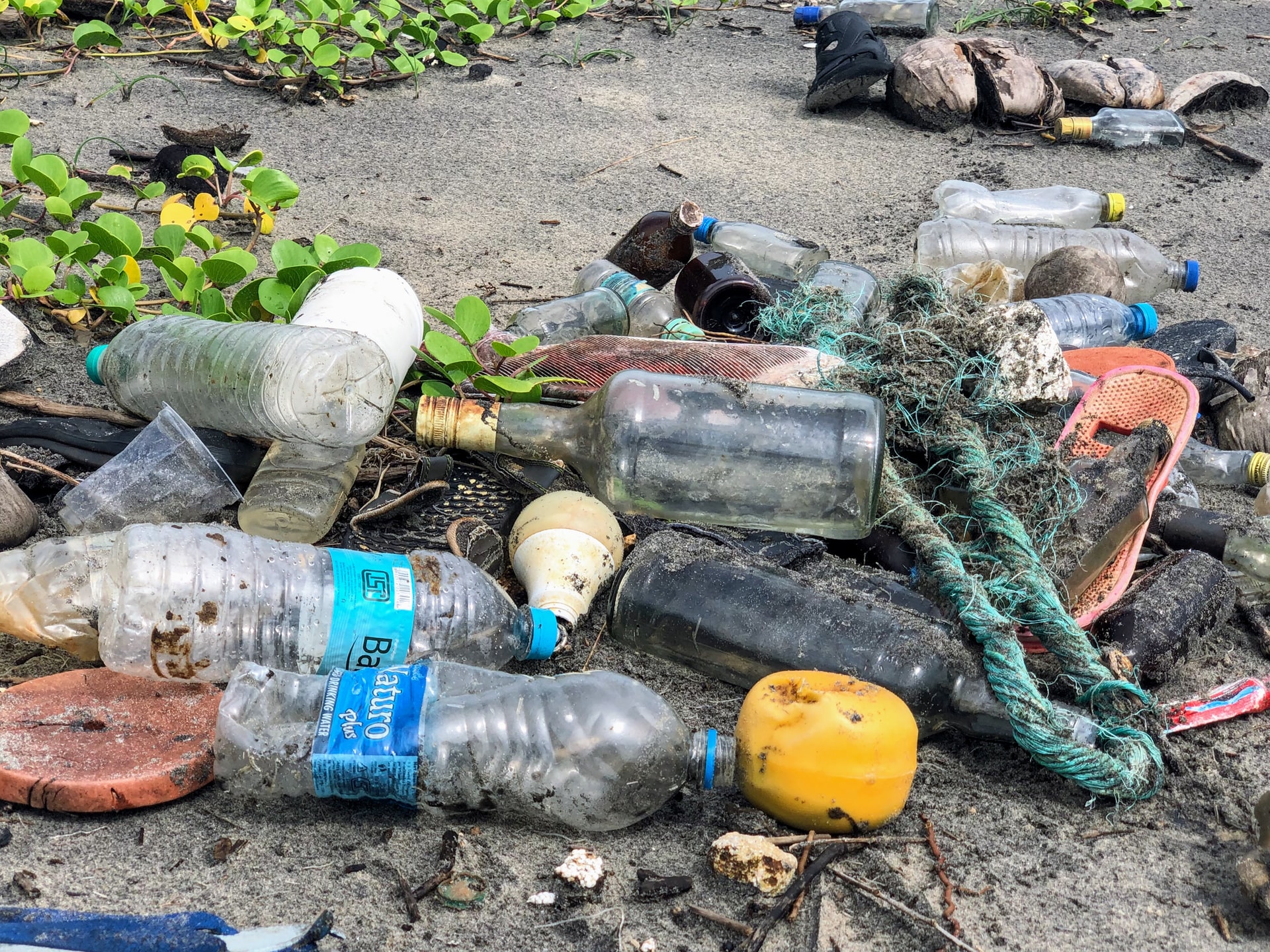Most Recent News


Popular News


Microplastics: an unescapable plague.

Say thanks to the Industrial Revolution for the fact that you eat a credit card’s worth of plastic every week:
Do you consume a credit card’s worth of plastic every week?
People worldwide could be ingesting five grammes of microscopic plastic particles every week, equivalent in weight to a credit card, researchers said Wednesday.
Coming mostly from tap and especially bottled water, nearly invisible bits of polymer were also found in shellfish, beer and salt, scientists and the University of Newcastle in Australia reported.
The findings, drawn from 52 peer-reviewed studies, are the first to estimate the sheer weight of plastics consumed by individual humans: about 250 grammes, or half-a-pound, over the course of a year.
Another study calculated that the average American eats and drinks in about 45,000 plastics particles smaller than 130 microns annually, while breathing in roughly the same number.
“Not only are plastics polluting our oceans and waterways and killing marine life, it’s in all of us,” said Marco Lambertini, director general of WWF International, which commissioned the new report.
“If we don’t want it in our bodies, we need to stop the millions of tons of plastic that continue leaking into Nature every year.”
The credit card you’re eating every week is probably not the Amex quality plastic, either. More like a Sears plastic quality. So, it adds some additional insult to injury.
And this trend is not decreasing. It’s increasing at a rapid pace. More plastic is being created and then subsequently dumped. As it degrades, it turns into the microplastics that are getting stuffed into every crevice of the planet. Including in your food and water. And the air and soil.
But don’t worry. The trustworthy FDA has been checking in on it. Because it’s not like they’ve been wrong consistently about nearly everything for the past few decades:
Why is this a problem? After all, manufacturers and certain regulatory agencies have long assured us that plastics are safe for human health. “In the U.S., we have a robust system that looks at materials that are in contact with food, and that includes plastics, managed by the [Food and Drug Administration],” says Karyn Schmidt, senior director of regulatory and technical affairs at the American Chemistry Council, an industry group that represents plastics and chemical manufacturers. “Consumers should feel very confident using any plastic coming into contact with food that they would buy in a grocery store.”
[…]
Some scientists say it’s likely that ingesting these tiny bits of plastic could expose us to harmful chemicals. “There cannot be no effect,” says Pete Myers, Ph.D., founder and chief scientist of the nonprofit Environmental Health Sciences and an adjunct professor of chemistry at Carnegie Mellon University in Pittsburgh.
“People have this idea that plastic is clean,” a sterile object that doesn’t come apart, says Sherri Mason, Ph.D., sustainability coordinator at Penn State Behrend in Erie, Pa., and a chemist who has studied the presence of plastic in tap water, beer, sea salt, and bottled water.
But, in fact, the raw materials of plastic are created from fossil fuels including oil and natural gas. And thousands of chemicals, depending on the product, are used to make it harder, softer, or more flexible. These chemicals include bisphenols, such as bisphenol A (BPA), and phthalates, which can flow or leach into the foods touched by plastic, especially when that plastic is warmed.
“It’s ironic that as public attention to this issue is really growing, global plastic production is increasing,” says Judith Enck, a former regional administrator for the Environmental Protection Agency, now a visiting professor at Bennington College in Vermont and president of Beyond Plastics, a nonprofit focused on ending plastics pollution. And as more plastic is produced and discarded, contaminating our water, food, and air, exposure levels for the average person will continue to rise.
It’s already becoming nearly impossible to eat healthy. The Western diet is ravaging us with things like endless seed oils and other processed garbage. Now we have to contend with even accidentally eating a (heavily chemically processed) plastic credit card every week. Thanks, Industrial Revolution.
If you want a visual of how much plastic this means you ingest over time, I recommend checking out this quick graphic. It’s a useful walkthrough.
In addition, these microplastics have been found practically everywhere. There is no escaping them. We’ve even found them in the hearts and lungs of most people:
The majority of us don’t purposefully eat plastic, but that doesn’t mean we’re not consuming it every day. Microplastics, which are tiny plastic fragments, are everywhere—including inside of our bodies, according to mounting research. For the first time, researchers found that 17 out of 22 people had microplastics originating from common products in their blood, according to a May 2021 paper published in the journal Environment International.
“This is the first study to identify plastics that we know are in containers, plastic bottles, clothing, and other products that we use, inside of people,” says Andrea De Vizcaya-Ruiz, PhD, an associate professor in the department of environmental and occupational health at the University of California, Irvine. The two most common types of plastic found in the study were polyethylene terephthalate (PET), which is used to make plastic water bottles and clothing fibres, and polystyrene, which is found in food packaging, disposable utensils, and straws.
In March 2022, researchers published a paper with another original discovery: 11 out of 13 people had microplastics in their lungs, according to the study published in The Science of the Total Environment. Numerous other studies support that we’re regularly consuming plastic, Kelly Johnson-Arbor, MD, a medical toxicologist at MedStar Health in Washington, D.C., and co-medical director at the National Capital Poison Center explains. “Microplastics have been found in human saliva, scalp, hair, and faeces, suggesting that we are all likely exposed to these plastic fragments on a regular basis,” she says.
Plastics are relatively new. They’re a child of the parent industrial revolution, coming in around the early 19th century. They became dominant because they would not degrade as easily as alternatives and were cheap. But therein lies the issues.
Microplastics are being found in our water, dirt, food, and even the air. Plastic does not decompose rapidly, so as it breaks down, it simply becomes the many microplastics that we later ingest. You can’t escape them. We all reap what we sow. It’s almost poetic—As if it is nature’s way of punishing us for creating them in the first place. We harm nature, nature harms us.
As of now, this is such a new phenomenon that we have absolutely no idea what it is doing to us health-wise. And yet, we keep producing more. Then we keep dumping more. Because plastic is easy. And the Industrial Revolution was all about revolutionizing things to make them easy, cheap, and usable for a massive global population with no regard to virtuous limitations. To focus on the dollar and profitability above all else.
There is no way that microplastics have a net positive or net neutral effect. They’re impacting us. We just don’t know how yet.
But we have some ideas:
How does it affect health?
There is evidence, at least in animals, that microplastics can cross the hardy membrane protecting the brain from many foreign bodies that get into the bloodstream. And there’s some evidence that mothers may be able to pass microplastics through the placenta to a developing fetus, according to research that has not yet been published but was presented at a spring conference at the Rutgers Center for Urban Environmental Sustainability.
Myers says some of these microplastic particles could potentially leach bisphenol A and phthalates. Bisphenols are known to interfere with hormones, and there are studies linking bisphenol exposure to reduced fertility in men and women, Flaws says, noting that phthalates are also known to disrupt hormones, and prenatal exposure to phthalates is linked to lower testosterone in male offspring.
Styrene, another chemical found in plastic and some food packaging, has also been linked to a number of health issues, including nervous system problems, hearing loss and cancer.
Flaws says microplastic particles can also accumulate polychlorinated biphenyls (PCBs), other chemicals that are linked to harmful health effects, including various cancers, a weakened immune system, reproductive problems and more.
Once these chemicals are inside of us, even low doses may have an effect.
No surprise there. Everything modernity provides has been targeting hormones, reproductive health, and child-rearing. You see this so many times and it’s hard not to think it’s a conspiracy to reduce the global population.
Do what you can. Avoid plastics like water bottles, especially previously recycled ones. Don’t use plastic when you can help it. Eat whole, fresh, local-organic foods. Keep it simple and follow my other article tips and you’ll naturally reduce your microplastic consumption.
But know that you can’t escape it all, not without first escaping modernity.
And that would require a new revolution to replace the industrial one.
Read Next:
A Nutrition Guide: The Basics Of Healthy Eating
Want To Keep Your Sperm? Stop Eating The Western Diet
MGTOW: Men Going The Wrong Way
If you enjoyed this article, bookmark the website and check back often for new content. New articles most weekdays.
You can also keep up with my writing by joining my monthly newsletter.
Help fight the censorship – Share this article!

(Learn More About The Dominion Newsletter Here)